NSC LM117MDA, LM117KSTEEL, LM117KGMW8, LM117KGMD8, LM117K-883 Datasheet
...
August 1999
LM117/LM317A/LM317
3-Terminal Adjustable Regulator
General Description
The LM117 series of adjustable 3-terminal positive voltage regulators is capable of supplying in excess of 1.5A over a 1.2V to 37V output range. They are exceptionally easy to use and require only two external resistors to set the output voltage. Further, both line and load regulation are better than standard fixed regulators. Also, the LM117 is packaged in standard transistor packages which are easily mounted and handled.
In addition to higher performance than fixed regulators, the LM117 series offers full overload protection available only in IC's. Included on the chip are current limit, thermal overload protection and safe area protection. All overload protection circuitry remains fully functional even if the adjustment terminal is disconnected.
Normally, no capacitors are needed unless the device is situated more than 6 inches from the input filter capacitors in which case an input bypass is needed. An optional output capacitor can be added to improve transient response. The adjustment terminal can be bypassed to achieve very high ripple rejection ratios which are difficult to achieve with standard 3-terminal regulators.
Besides replacing fixed regulators, the LM117 is useful in a wide variety of other applications. Since the regulator is ªfloatingº and sees only the input-to-output differential volt-
age, supplies of several hundred volts can be regulated as long as the maximum input to output differential is not exceeded, i.e., avoid short-circuiting the output.
Also, it makes an especially simple adjustable switching regulator, a programmable output regulator, or by connecting a fixed resistor between the adjustment pin and output, the LM117 can be used as a precision current regulator. Supplies with electronic shutdown can be achieved by clamping the adjustment terminal to ground which programs the output to 1.2V where most loads draw little current.
For applications requiring greater output current, see LM150 series (3A) and LM138 series (5A) data sheets. For the negative complement, see LM137 series data sheet.
Features
nGuaranteed 1% output voltage tolerance (LM317A)
nGuaranteed max. 0.01%/V line regulation (LM317A)
nGuaranteed max. 0.3% load regulation (LM117)
nGuaranteed 1.5A output current
nAdjustable output down to 1.2V
nCurrent limit constant with temperature
nP+ Product Enhancement tested
n80 dB ripple rejection
nOutput is short-circuit protected
Typical Applications
1.2V±25V Adjustable Regulator
DS009063-1
Full output current not available at high input-output voltages *Needed if device is more than 6 inches from filter capacitors.
²Optional Ð improves transient response. Output capacitors in the range of 1 µF to 1000 µF of aluminum or tantalum electrolytic are commonly used to provide improved output impedance and rejection of transients.
LM117 Series Packages
Part Number |
|
Design |
Suffix |
Package |
Load |
|
|
Current |
|
|
|
K |
TO-3 |
1.5A |
|
|
|
H |
TO-39 |
0.5A |
|
|
|
T |
TO-220 |
1.5A |
|
|
|
E |
LCC |
0.5A |
|
|
|
S |
TO-263 |
1.5A |
|
|
|
EMP |
SOT-223 |
1A |
|
|
|
MDT |
TO-252 |
0.5A |
|
|
|
SOT-223 vs D-Pak (TO-252) Packages
DS009063-54
Scale 1:1
Regulator Adjustable Terminal-3 LM117/LM317A/LM317
© 1999 National Semiconductor Corporation |
DS009063 |
www.national.com |

Absolute Maximum Ratings (Note 1)
If Military/Aerospace specified devices are required, please contact the National Semiconductor Sales Office/ Distributors for availability and specifications.
Power Dissipation |
Internally Limited |
Input-Output Voltage Differential |
+40V, −0.3V |
Storage Temperature |
−65ÊC to +150ÊC |
Lead Temperature |
|
Metal Package (Soldering, 10 seconds) |
300ÊC |
Plastic Package (Soldering, 4 seconds) |
260ÊC |
ESD Tolerance (Note 5) |
3 kV |
Electrical Characteristics (Note 3)
Operating Temperature Range
LM117 |
−55ÊC |
≤ TJ ≤ +150ÊC |
LM317A |
−40ÊC |
≤ TJ ≤ +125ÊC |
LM317 |
0ÊC ≤ TJ ≤ +125ÊC |
|
Preconditioning
Thermal Limit Burn-In All Devices 100%
Specifications with standard type face are for TJ = 25ÊC, and those with boldface type apply over full Operating Temperature Range. Unless otherwise specified, VIN − V OUT = 5V, and IOUT = 10 mA.
Parameter |
Conditions |
|
LM117 (Note 2) |
|
Units |
||
|
|
|
|
|
|
|
|
|
|
Min |
|
Typ |
|
Max |
|
Reference Voltage |
|
|
|
|
|
|
V |
|
|
|
|
|
|
|
|
|
3V ≤ (VIN − V OUT) ≤ 40V, |
1.20 |
|
1.25 |
|
1.30 |
V |
|
10 mA ≤ IOUT ≤ IMAX, P ≤ PMAX |
|
|
|
|
|
|
Line Regulation |
3V ≤ (VIN − V OUT) ≤ 40V (Note 4) |
|
|
0.01 |
|
0.02 |
%/V |
|
|
|
|
0.02 |
|
0.05 |
%/V |
|
|
|
|
|
|
|
|
Load Regulation |
10 mA ≤ IOUT ≤ IMAX (Note 4) |
|
|
0.1 |
|
0.3 |
% |
|
|
|
|
0.3 |
|
1 |
% |
|
|
|
|
|
|
|
|
Thermal Regulation |
20 ms Pulse |
|
|
0.03 |
|
0.07 |
%/W |
Adjustment Pin Current |
|
|
|
50 |
|
100 |
µA |
|
|
|
|
|
|
|
|
Adjustment Pin Current Change |
10 mA ≤ IOUT ≤ IMAX |
|
|
0.2 |
|
5 |
µA |
|
3V ≤ (VIN − V OUT) ≤ 40V |
|
|
|
|
|
|
Temperature Stability |
TMIN ≤ TJ ≤ TMAX |
|
|
1 |
|
|
% |
Minimum Load Current |
(VIN − V OUT) = 40V |
|
|
3.5 |
|
5 |
mA |
Current Limit |
(VIN − V OUT) ≤ 15V |
|
|
|
|
|
|
|
K Package |
1.5 |
|
2.2 |
|
3.4 |
A |
|
H Packages |
0.5 |
|
0.8 |
|
1.8 |
A |
|
|
|
|
|
|
|
|
|
(VIN − V OUT) = 40V |
|
|
|
|
|
|
|
K Package |
0.3 |
|
0.4 |
|
|
A |
|
H Package |
0.15 |
|
0.2 |
|
|
A |
|
|
|
|
|
|
|
|
RMS Output Noise, % of VOUT |
10 Hz ≤ f ≤ 10 kHz |
|
|
0.003 |
|
|
% |
Ripple Rejection Ratio |
VOUT = 10V, f = 120 Hz, |
|
|
65 |
|
|
dB |
|
CADJ = 0 µF |
|
|
|
|
|
|
|
VOUT = 10V, f = 120 Hz, |
66 |
|
80 |
|
|
dB |
|
CADJ = 10 µF |
|
|
|
|
|
|
Long-Term Stability |
TJ = 125ÊC, 1000 hrs |
|
|
0.3 |
|
1 |
% |
Thermal Resistance, |
K Package |
|
|
2.3 |
|
3 |
ÊC/W |
Junction-to-Case |
H Package |
|
|
12 |
|
15 |
ÊC/W |
|
E Package |
|
|
|
|
|
ÊC/W |
|
|
|
|
|
|
|
|
Thermal Resistance, Junction- |
K Package |
|
|
35 |
|
|
ÊC/W |
to-Ambient (No Heat Sink) |
H Package |
|
|
140 |
|
|
ÊC/W |
|
E Package |
|
|
|
|
|
ÊC/W |
|
|
|
|
|
|
|
|
www.national.com |
2 |

Electrical Characteristics (Note 3)
Specifications with standard type face are for TJ = 25ÊC, and those with boldface type apply over full Operating Temperature Range. Unless otherwise specified, VIN − V OUT = 5V, and IOUT = 10 mA.
Parameter |
Conditions |
|
LM317A |
|
|
LM317 |
|
Units |
|
|
|
|
|
|
|
|
|
|
|
Min |
Typ |
Max |
Min |
Typ |
Max |
|
|
|
|
|
|
|
|
|
|
Reference Voltage |
|
1.238 |
1.250 |
1.262 |
|
|
|
V |
|
|
|
|
|
|
|
|
|
|
3V ≤ (VIN − V OUT) ≤ 40V, |
1.225 |
1.250 |
1.270 |
1.20 |
1.25 |
1.30 |
V |
|
10 mA ≤ IOUT ≤ IMAX, P ≤ PMAX |
|
|
|
|
|
|
|
Line Regulation |
3V ≤ (VIN − V OUT) ≤ 40V (Note 4) |
|
0.005 |
0.01 |
|
0.01 |
0.04 |
%/V |
|
|
|
0.01 |
0.02 |
|
0.02 |
0.07 |
%/V |
|
|
|
|
|
|
|
|
|
Load Regulation |
10 mA ≤ IOUT ≤ IMAX (Note 4) |
|
0.1 |
0.5 |
|
0.1 |
0.5 |
% |
|
|
|
0.3 |
1 |
|
0.3 |
1.5 |
% |
|
|
|
|
|
|
|
|
|
Thermal Regulation |
20 ms Pulse |
|
0.04 |
0.07 |
|
0.04 |
0.07 |
%/W |
|
|
|
|
|
|
|
|
|
Adjustment Pin Current |
|
|
50 |
100 |
|
50 |
100 |
µA |
|
|
|
|
|
|
|
|
|
Adjustment Pin Current |
10 mA ≤ IOUT ≤ IMAX |
|
0.2 |
5 |
|
0.2 |
5 |
µA |
Change |
3V ≤ (VIN − V OUT) ≤ 40V |
|
|
|
|
|
|
|
Temperature Stability |
TMIN ≤ TJ ≤ TMAX |
|
1 |
|
|
1 |
|
% |
Minimum Load Current |
(VIN − V OUT) = 40V |
|
3.5 |
10 |
|
3.5 |
10 |
mA |
Current Limit |
(VIN − V OUT) ≤ 15V |
|
|
|
|
|
|
|
|
K, T, S Packages |
1.5 |
2.2 |
3.4 |
1.5 |
2.2 |
3.4 |
A |
|
H Package |
0.5 |
0.8 |
1.8 |
0.5 |
0.8 |
1.8 |
A |
|
MP Package |
1.5 |
2.2 |
3.4 |
1.5 |
2.2 |
3.4 |
A |
|
|
|
|
|
|
|
|
|
|
(VIN − V OUT) = 40V |
|
|
|
|
|
|
|
|
K, T, S Packages |
0.15 |
0.4 |
|
0.15 |
0.4 |
|
A |
|
H Package |
0.075 |
0.2 |
|
0.075 |
0.2 |
|
A |
|
MP Package |
0.55 |
0.4 |
|
0.15 |
0.4 |
|
A |
|
|
|
|
|
|
|
|
|
RMS Output Noise, % of VOUT |
10 Hz ≤ f ≤ 10 kHz |
|
0.003 |
|
|
0.003 |
|
% |
Ripple Rejection Ratio |
VOUT = 10V, f = 120 Hz, |
|
65 |
|
|
65 |
|
dB |
|
CADJ = 0 µF |
|
|
|
|
|
|
|
|
VOUT = 10V, f = 120 Hz, |
66 |
80 |
|
66 |
80 |
|
dB |
|
CADJ = 10 µF |
|
|
|
|
|
|
|
Long-Term Stability |
TJ = 125ÊC, 1000 hrs |
|
0.3 |
1 |
|
0.3 |
1 |
% |
Thermal Resistance, |
K Package |
|
|
|
|
2.3 |
3 |
ÊC/W |
Junction-to-Case |
MDT Package |
|
|
|
|
5 |
|
ÊC/W |
|
H Package |
|
12 |
15 |
|
12 |
15 |
ÊC/W |
|
T Package |
|
4 |
5 |
|
4 |
|
ÊC/W |
|
MP Package |
|
23.5 |
|
|
23.5 |
|
ÊC/W |
|
|
|
|
|
|
|
|
|
Thermal Resistance, |
K Package |
|
35 |
|
|
35 |
|
ÊC/W |
Junction-to-Ambient (No Heat |
MDT Package(Note 6) |
|
|
|
|
92 |
|
ÊC/W |
Sink) |
H Package |
|
140 |
|
|
140 |
|
ÊC/W |
|
T Package |
|
50 |
|
|
50 |
|
ÊC/W |
|
S Package (Note 6) |
|
50 |
|
|
50 |
|
ÊC/W |
|
|
|
|
|
|
|
|
|
Note 1: Absolute Maximum Ratings indicate limits beyond which damage to the device may occur. Operating Ratings indicate conditions for which the device is intended to be functional, but do not guarantee specific performance limits. For guaranteed specifications and test conditions, see the Electrical Characteristics. The guaranteed specifications apply only for the test conditions listed.
Note 2: Refer to RETS117H drawing for the LM117H, or the RETS117K for the LM117K military specifications.
Note 3: Although power dissipation is internally limited, these specifications are applicable for maximum power dissipations of 2W for the TO-39 and SOT-223 and
20W for the TO-3, TO-220, and TO-263. IMAX is 1.5A for the TO-3, TO-220, and TO-263 packages, 0.5A for the TO-39 package and 1A for the SOT-223 Package. All limits (i.e., the numbers in the Min. and Max. columns) are guaranteed to National's AOQL (Average Outgoing Quality Level).
Note 4: Regulation is measured at a constant junction temperature, using pulse testing with a low duty cycle. Changes in output voltage due to heating effects are covered under the specifications for thermal regulation.
Note 5: Human body model, 100 pF discharged through a 1.5 kΩ resistor.
Note 6: If the TO-263 or TO-252 packages are used, the thermal resistance can be reduced by increasing the PC board copper area thermally connected to the package. If the SOT-223 package is used, the thermal resistance can be reduced by increasing the PC board copper area (see applications hints for heatsinking).
3 |
www.national.com |
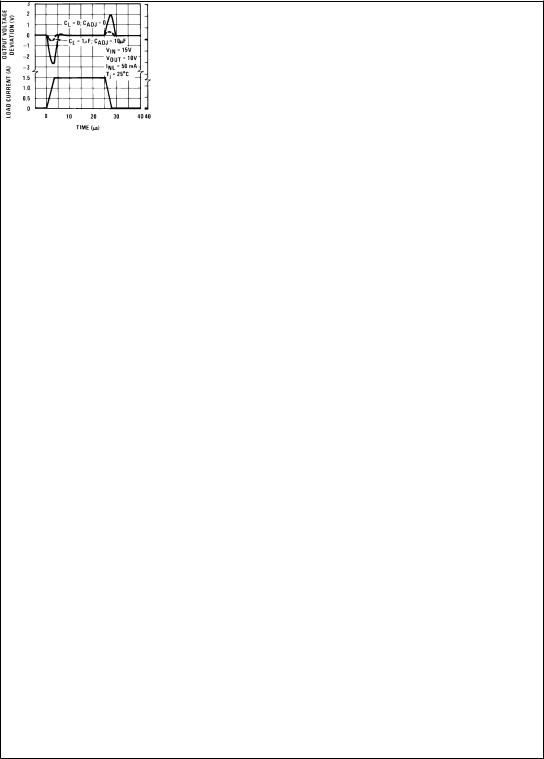
Typical Performance Characteristics
Output Capacitor = 0 µF unless otherwise noted
Load Regulation |
Current Limit |
Adjustment Current |
DS009063-37
Dropout Voltage
DS009063-40
Ripple Rejection
DS009063-43
Output Impedance
DS009063-46
DS009063-38
Temperature Stability
DS009063-41
Ripple Rejection
DS009063-44
Line Transient Response
DS009063-47
DS009063-39
Minimum Operating Current
DS009063-42
Ripple Rejection
DS009063-45
Load Transient Response
DS009063-48
www.national.com |
4 |
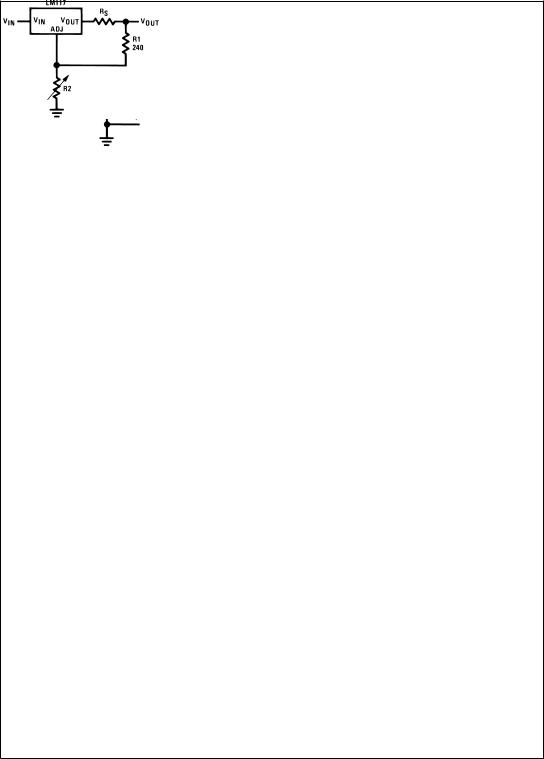
Application Hints
In operation, the LM117 develops a nominal 1.25V reference voltage, VREF, between the output and adjustment terminal. The reference voltage is impressed across program resistor R1 and, since the voltage is constant, a constant current I1 then flows through the output set resistor R2, giving an output voltage of
DS009063-5
FIGURE 1.
Since the 100 µA current from the adjustment terminal represents an error term, the LM117 was designed to minimize IADJ and make it very constant with line and load changes. To do this, all quiescent operating current is returned to the output establishing a minimum load current requirement. If there is insufficient load on the output, the output will rise.
External Capacitors
An input bypass capacitor is recommended. A 0.1 µF disc or 1 µF solid tantalum on the input is suitable input bypassing for almost all applications. The device is more sensitive to the absence of input bypassing when adjustment or output capacitors are used but the above values will eliminate the possibility of problems.
The adjustment terminal can be bypassed to ground on the LM117 to improve ripple rejection. This bypass capacitor prevents ripple from being amplified as the output voltage is increased. With a 10 µF bypass capacitor 80 dB ripple rejection is obtainable at any output level. Increases over 10 µF do not appreciably improve the ripple rejection at frequencies above 120 Hz. If the bypass capacitor is used, it is sometimes necessary to include protection diodes to prevent the capacitor from discharging through internal low current paths and damaging the device.
In general, the best type of capacitors to use is solid tantalum. Solid tantalum capacitors have low impedance even at high frequencies. Depending upon capacitor construction, it takes about 25 µF in aluminum electrolytic to equal 1 µF solid tantalum at high frequencies. Ceramic capacitors are also good at high frequencies; but some types have a large decrease in capacitance at frequencies around 0.5 MHz. For this reason, 0.01 µF disc may seem to work better than a 0.1 µF disc as a bypass.
Although the LM117 is stable with no output capacitors, like any feedback circuit, certain values of external capacitance can cause excessive ringing. This occurs with values between 500 pF and 5000 pF. A 1 µF solid tantalum (or 25 µF
aluminum electrolytic) on the output swamps this effect and insures stability. Any increase of the load capacitance larger than 10 µF will merely improve the loop stability and output impedance.
Load Regulation
The LM117 is capable of providing extremely good load regulation but a few precautions are needed to obtain maximum performance. The current set resistor connected between the adjustment terminal and the output terminal (usually 240Ω) should be tied directly to the output (case) of the regulator rather than near the load. This eliminates line drops from appearing effectively in series with the reference and degrading regulation. For example, a 15V regulator with 0.05Ω resistance between the regulator and load will have a load regulation due to line resistance of 0.05Ω x IL. If the set resistor is connected near the load the effective line resistance will be 0.05Ω (1 + R2/R1) or in this case, 11.5 times worse.
Figure 2 shows the effect of resistance between the regulator and 240Ω set resistor.
DS009063-6
FIGURE 2. Regulator with Line Resistance in Output Lead
With the TO-3 package, it is easy to minimize the resistance from the case to the set resistor, by using two separate leads to the case. However, with the TO-39 package, care should be taken to minimize the wire length of the output lead. The ground of R2 can be returned near the ground of the load to provide remote ground sensing and improve load regulation.
Protection Diodes
When external capacitors are used with any IC regulator it is sometimes necessary to add protection diodes to prevent the capacitors from discharging through low current points into the regulator. Most 10 µF capacitors have low enough internal series resistance to deliver 20A spikes when shorted. Although the surge is short, there is enough energy to damage parts of the IC.
When an output capacitor is connected to a regulator and the input is shorted, the output capacitor will discharge into the output of the regulator. The discharge current depends on the value of the capacitor, the output voltage of the regulator, and the rate of decrease of VIN. In the LM117, this discharge path is through a large junction that is able to sustain 15A surge with no problem. This is not true of other types of positive regulators. For output capacitors of 25 µF or less, there is no need to use diodes.
The bypass capacitor on the adjustment terminal can discharge through a low current junction. Discharge occurs when either the input or output is shorted. Internal to the LM117 is a 50Ω resistor which limits the peak discharge current. No protection is needed for output voltages of 25V or
5 |
www.national.com |
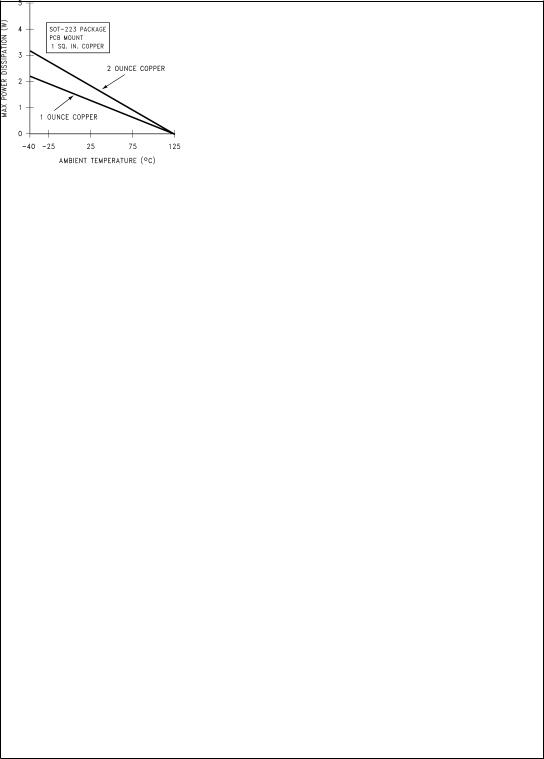
Application Hints (Continued)
less and 10 µF capacitance. Figure 3 shows an LM117 with protection diodes included for use with outputs greater than 25V and high values of output capacitance.
DS009063-7
D1 protects against C1
D2 protects against C2
FIGURE 3. Regulator with Protection Diodes
When a value for θ(H−A) is found using the equation shown, a heatsink must be selected that has a value that is less than
or equal to this number.
θ(H−A) is specified numerically by the heatsink manufacturer in the catalog, or shown in a curve that plots temperature rise vs power dissipation for the heatsink.
HEATSINKING TO-263, SOT-223 AND TO-252 PACKAGE PARTS
The TO-263 (ªSº), SOT-223 (ªMPº) and TO-252 (ºDTº) packages use a copper plane on the PCB and the PCB itself as
a heatsink. To optimize the heat sinking ability of the plane and PCB, solder the tab of the package to the plane.
Figure 4 shows for the TO-263 the measured values of θ(J−A) for different copper area sizes using a typical PCB with 1
ounce copper and no solder mask over the copper area used for heatsinking.
DS009063-55
FIGURE 4. θ(J−A) vs Copper (1 ounce) Area for the
TO-263 Package
As shown in the figure, increasing the copper area beyond 1 square inch produces very little improvement. It should also
be observed that the minimum value of θ(J−A) for the TO-263 package mounted to a PCB is 32ÊC/W.
As a design aid, Figure 5 shows the maximum allowable power dissipation compared to ambient temperature for the
TO-263 device (assuming θ(J−A) is 35ÊC/W and the maximum junction temperature is 125ÊC).
DS009063-56
FIGURE 5. Maximum Power Dissipation vs TAMB for the TO-263 Package
Figure 6 and Figure 7 show the information for the SOT-223
package. Figure 7 assumes a θ(J−A) of 74ÊC/W for 1 ounce copper and 51ÊC/W for 2 ounce copper and a maximum
junction temperature of 125ÊC.
DS009063-57
FIGURE 6. θ(J−A) vs Copper (2 ounce) Area for the
SOT-223 Package
DS009063-58
FIGURE 7. Maximum Power Dissipation vs TAMB for the SOT-223 Package
www.national.com |
6 |
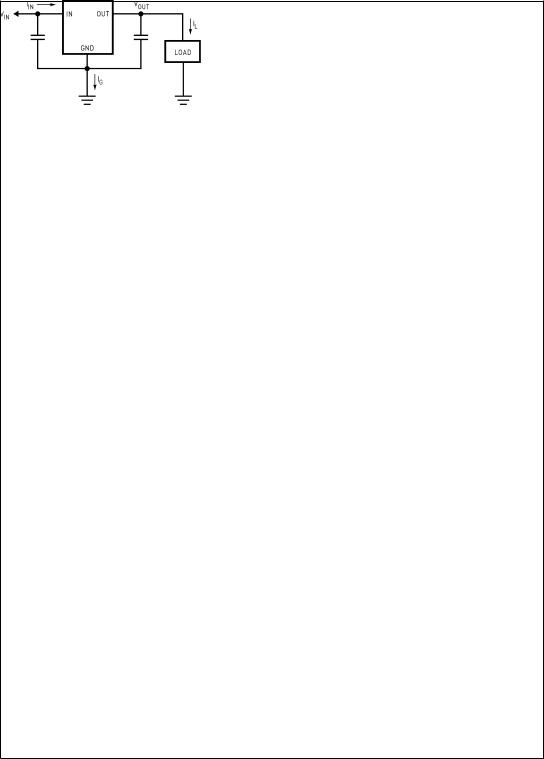
Application Hints (Continued)
The LM317 regulators have internal thermal shutdown to protect the device from over-heating. Under all possible operating conditions, the junction temperature of the LM317 must be within the range of 0ÊC to 125ÊC. A heatsink may be required depending on the maximum power dissipation and maximum ambient temperature of the application. To determine if a heatsink is needed, the power dissipated by the regulator, PD, must be calculated:
IIN = IL + IG
PD = (VIN − V OUT) IL + VINIG
Figure 8 shows the voltage and currents which are present in the circuit.
DS009063-60
FIGURE 8. Power Dissipation Diagram
The next parameter which must be calculated is the maximum allowable temperature rise, TR(max):
TR(max) = TJ(max) − T A(max)
where TJ(max) is the maximum allowable junction temperature (125ÊC), and TA(max) is the maximum ambient temperature which will be encountered in the application.
Using the calculated values for TR(max) and PD, the maximum allowable value for the junction-to-ambient thermal resistance (qJA) can be calculated:
qJA = TR(max)/PD
If the maximum allowable value for qJA is found to be ³92ÊC/W (Typical Rated Value) for TO-252 package, no heatsink is needed since the package alone will dissipate enough heat to satisfy these requirements. If the calculated value for qJA falls below these limits, a heatsink is required.
As a design aid, Table 1 shows the value of the qJA of TO-252 for different heatsink area. The copper patterns that we used to measure these qJAs are shown at the end of the Application Notes Section. Figure 9 reflects the same test results as what are in the Table 1
Figure 10 shows the maximum allowable power dissipation vs. ambient temperature for the TO-252 device. Figure 11 shows the maximum allowable power dissipation vs. copper area (in2) for the TO-252 device. Please see AN1028 for power enhancement techniques to be used with SOT-223 and TO-252 packages.
TABLE 1. qJA Different Heatsink Area
Layout |
Copper Area |
|
Thermal Resistance |
|
|
|
|
|
|
|
Top Side (in2)* |
|
Bottom Side (in2) |
(qJAÊC/W) TO-252 |
1 |
0.0123 |
|
0 |
103 |
|
|
|
|
|
2 |
0.066 |
|
0 |
87 |
|
|
|
|
|
3 |
0.3 |
|
0 |
60 |
|
|
|
|
|
4 |
0.53 |
|
0 |
54 |
|
|
|
|
|
5 |
0.76 |
|
0 |
52 |
|
|
|
|
|
6 |
1 |
|
0 |
47 |
|
|
|
|
|
7 |
0 |
|
0.2 |
84 |
8 |
0 |
|
0.4 |
70 |
|
|
|
|
|
9 |
0 |
|
0.6 |
63 |
|
|
|
|
|
10 |
0 |
|
0.8 |
57 |
|
|
|
|
|
11 |
0 |
|
1 |
57 |
12 |
0.066 |
|
0.066 |
89 |
|
|
|
|
|
13 |
0.175 |
|
0.175 |
72 |
|
|
|
|
|
14 |
0.284 |
|
0.284 |
61 |
|
|
|
|
|
15 |
0.392 |
|
0.392 |
55 |
|
|
|
|
|
16 |
0.5 |
|
0.5 |
53 |
|
|
|
|
|
Note: * Tab of device attached to topside of copper.
7 |
www.national.com |
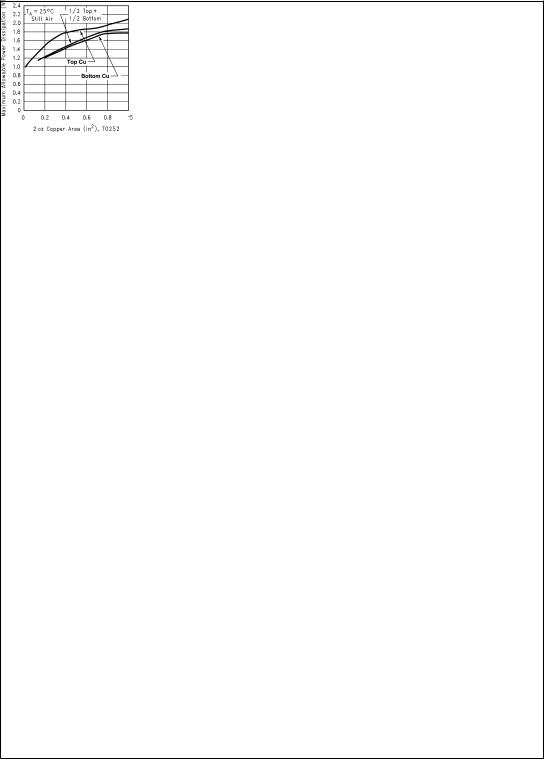
Application Hints (Continued)
DS009063-61
FIGURE 9. θJA vs 2oz Copper Area for TO-252
DS009063-63
FIGURE 10. Maximum Allowable Power Dissipation vs. Ambient Temperature for TO-252
DS009063-62
FIGURE 11. Maximum Allowable Power Dissipation vs. 2oz Copper Area for TO-252
www.national.com |
8 |
